Case Study: Supporting Julian Cope with Parental Separation - EDUC 653
VerifiedAdded on 2023/03/31
|5
|976
|169
Case Study
AI Summary
This case study examines the challenges faced by Julian Cope, a five-year-old kindergarten student, and the strategies employed by his teacher, Mingmei Wong, to support his development. Julian exhibits antisocial behaviors, including playing alone and hitting peers, prompting the teacher to utilize anecdotal observations to understand his behavior. Teacher Mingmei collaborates with Julian's parent to gather information about the child's home life, revealing that parental separation significantly impacts his behavior. Armed with this knowledge, the teacher develops a targeted plan to integrate Julian into social activities and address his emotional needs. The case study highlights the importance of teacher-parent collaboration, anecdotal observation, and tailored interventions in supporting children facing emotional challenges related to family dynamics. The teacher implements strategies to include Julian in play and modifies her social studies curriculum to reflect diverse family structures, ultimately helping him adapt to kindergarten.
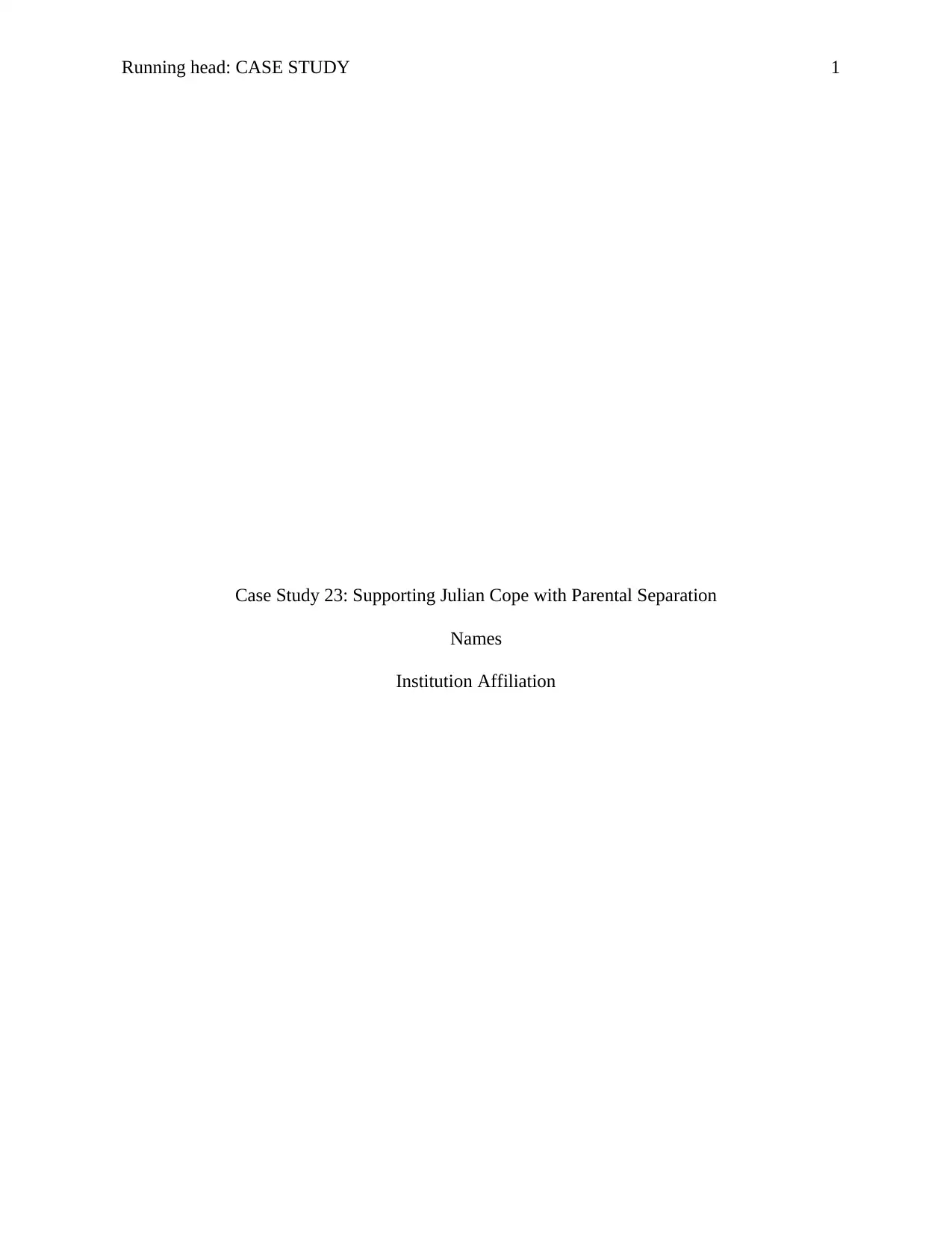
Running head: CASE STUDY 1
Case Study 23: Supporting Julian Cope with Parental Separation
Names
Institution Affiliation
Case Study 23: Supporting Julian Cope with Parental Separation
Names
Institution Affiliation
Paraphrase This Document
Need a fresh take? Get an instant paraphrase of this document with our AI Paraphraser
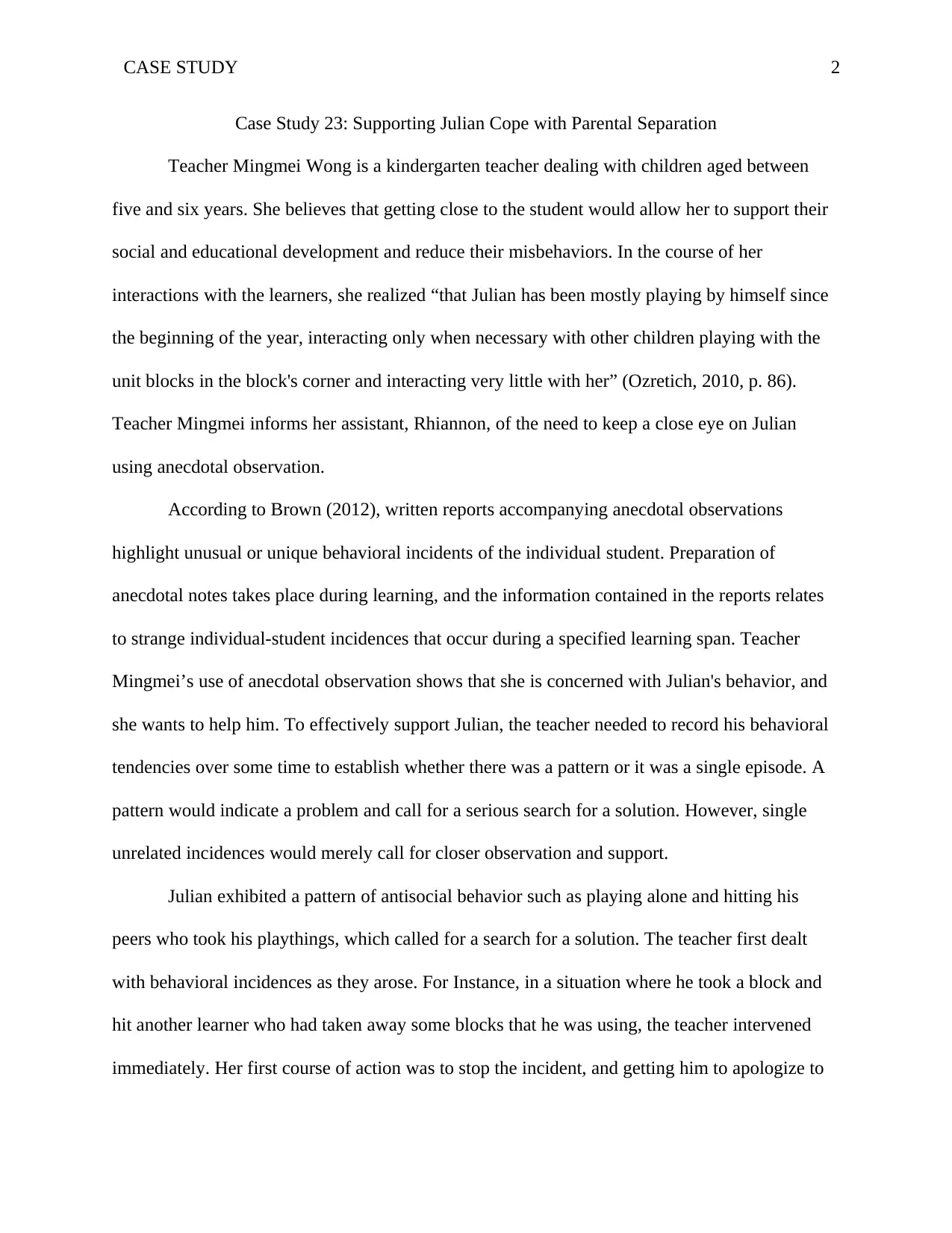
CASE STUDY 2
Case Study 23: Supporting Julian Cope with Parental Separation
Teacher Mingmei Wong is a kindergarten teacher dealing with children aged between
five and six years. She believes that getting close to the student would allow her to support their
social and educational development and reduce their misbehaviors. In the course of her
interactions with the learners, she realized “that Julian has been mostly playing by himself since
the beginning of the year, interacting only when necessary with other children playing with the
unit blocks in the block's corner and interacting very little with her” (Ozretich, 2010, p. 86).
Teacher Mingmei informs her assistant, Rhiannon, of the need to keep a close eye on Julian
using anecdotal observation.
According to Brown (2012), written reports accompanying anecdotal observations
highlight unusual or unique behavioral incidents of the individual student. Preparation of
anecdotal notes takes place during learning, and the information contained in the reports relates
to strange individual-student incidences that occur during a specified learning span. Teacher
Mingmei’s use of anecdotal observation shows that she is concerned with Julian's behavior, and
she wants to help him. To effectively support Julian, the teacher needed to record his behavioral
tendencies over some time to establish whether there was a pattern or it was a single episode. A
pattern would indicate a problem and call for a serious search for a solution. However, single
unrelated incidences would merely call for closer observation and support.
Julian exhibited a pattern of antisocial behavior such as playing alone and hitting his
peers who took his playthings, which called for a search for a solution. The teacher first dealt
with behavioral incidences as they arose. For Instance, in a situation where he took a block and
hit another learner who had taken away some blocks that he was using, the teacher intervened
immediately. Her first course of action was to stop the incident, and getting him to apologize to
Case Study 23: Supporting Julian Cope with Parental Separation
Teacher Mingmei Wong is a kindergarten teacher dealing with children aged between
five and six years. She believes that getting close to the student would allow her to support their
social and educational development and reduce their misbehaviors. In the course of her
interactions with the learners, she realized “that Julian has been mostly playing by himself since
the beginning of the year, interacting only when necessary with other children playing with the
unit blocks in the block's corner and interacting very little with her” (Ozretich, 2010, p. 86).
Teacher Mingmei informs her assistant, Rhiannon, of the need to keep a close eye on Julian
using anecdotal observation.
According to Brown (2012), written reports accompanying anecdotal observations
highlight unusual or unique behavioral incidents of the individual student. Preparation of
anecdotal notes takes place during learning, and the information contained in the reports relates
to strange individual-student incidences that occur during a specified learning span. Teacher
Mingmei’s use of anecdotal observation shows that she is concerned with Julian's behavior, and
she wants to help him. To effectively support Julian, the teacher needed to record his behavioral
tendencies over some time to establish whether there was a pattern or it was a single episode. A
pattern would indicate a problem and call for a serious search for a solution. However, single
unrelated incidences would merely call for closer observation and support.
Julian exhibited a pattern of antisocial behavior such as playing alone and hitting his
peers who took his playthings, which called for a search for a solution. The teacher first dealt
with behavioral incidences as they arose. For Instance, in a situation where he took a block and
hit another learner who had taken away some blocks that he was using, the teacher intervened
immediately. Her first course of action was to stop the incident, and getting him to apologize to
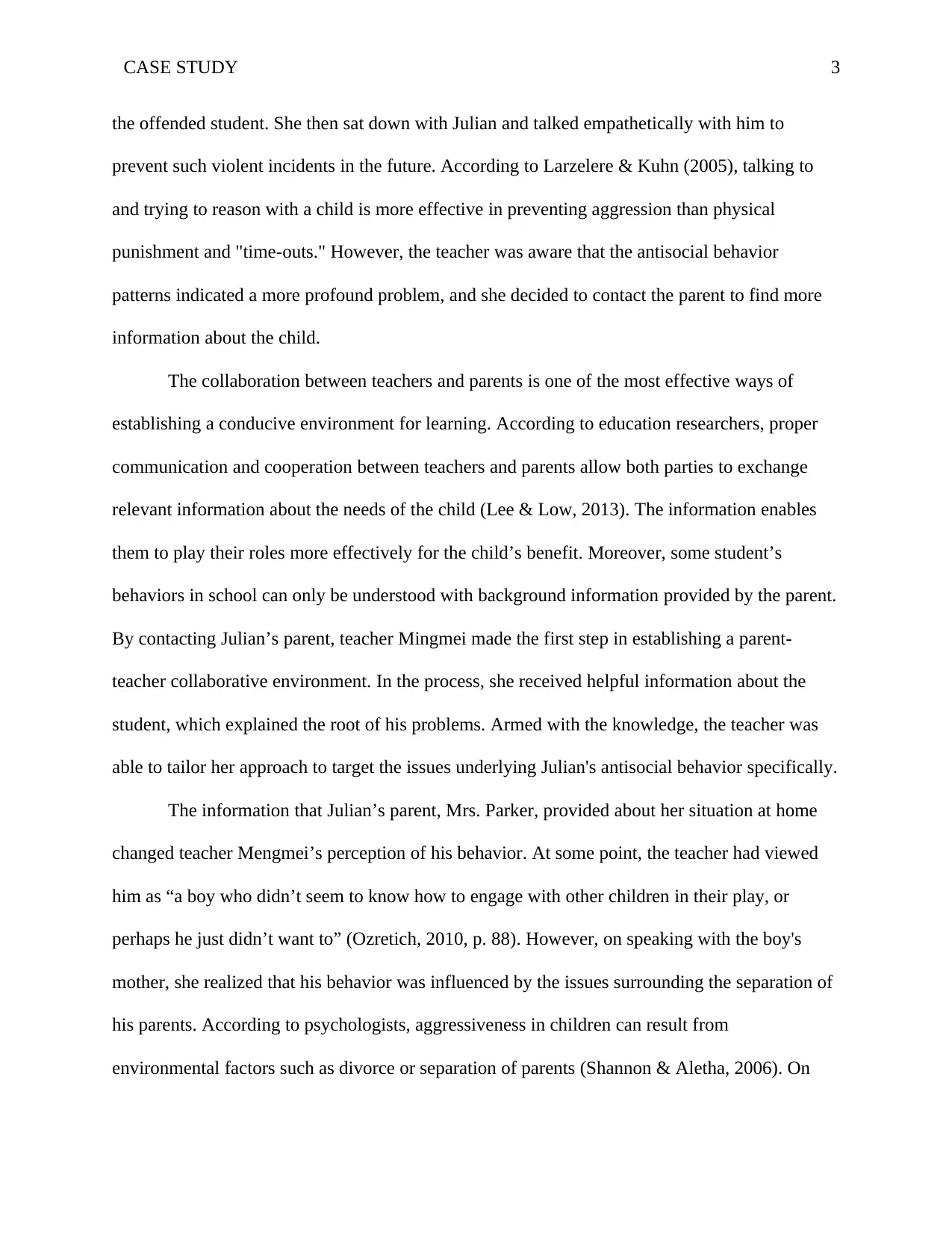
CASE STUDY 3
the offended student. She then sat down with Julian and talked empathetically with him to
prevent such violent incidents in the future. According to Larzelere & Kuhn (2005), talking to
and trying to reason with a child is more effective in preventing aggression than physical
punishment and "time-outs." However, the teacher was aware that the antisocial behavior
patterns indicated a more profound problem, and she decided to contact the parent to find more
information about the child.
The collaboration between teachers and parents is one of the most effective ways of
establishing a conducive environment for learning. According to education researchers, proper
communication and cooperation between teachers and parents allow both parties to exchange
relevant information about the needs of the child (Lee & Low, 2013). The information enables
them to play their roles more effectively for the child’s benefit. Moreover, some student’s
behaviors in school can only be understood with background information provided by the parent.
By contacting Julian’s parent, teacher Mingmei made the first step in establishing a parent-
teacher collaborative environment. In the process, she received helpful information about the
student, which explained the root of his problems. Armed with the knowledge, the teacher was
able to tailor her approach to target the issues underlying Julian's antisocial behavior specifically.
The information that Julian’s parent, Mrs. Parker, provided about her situation at home
changed teacher Mengmei’s perception of his behavior. At some point, the teacher had viewed
him as “a boy who didn’t seem to know how to engage with other children in their play, or
perhaps he just didn’t want to” (Ozretich, 2010, p. 88). However, on speaking with the boy's
mother, she realized that his behavior was influenced by the issues surrounding the separation of
his parents. According to psychologists, aggressiveness in children can result from
environmental factors such as divorce or separation of parents (Shannon & Aletha, 2006). On
the offended student. She then sat down with Julian and talked empathetically with him to
prevent such violent incidents in the future. According to Larzelere & Kuhn (2005), talking to
and trying to reason with a child is more effective in preventing aggression than physical
punishment and "time-outs." However, the teacher was aware that the antisocial behavior
patterns indicated a more profound problem, and she decided to contact the parent to find more
information about the child.
The collaboration between teachers and parents is one of the most effective ways of
establishing a conducive environment for learning. According to education researchers, proper
communication and cooperation between teachers and parents allow both parties to exchange
relevant information about the needs of the child (Lee & Low, 2013). The information enables
them to play their roles more effectively for the child’s benefit. Moreover, some student’s
behaviors in school can only be understood with background information provided by the parent.
By contacting Julian’s parent, teacher Mingmei made the first step in establishing a parent-
teacher collaborative environment. In the process, she received helpful information about the
student, which explained the root of his problems. Armed with the knowledge, the teacher was
able to tailor her approach to target the issues underlying Julian's antisocial behavior specifically.
The information that Julian’s parent, Mrs. Parker, provided about her situation at home
changed teacher Mengmei’s perception of his behavior. At some point, the teacher had viewed
him as “a boy who didn’t seem to know how to engage with other children in their play, or
perhaps he just didn’t want to” (Ozretich, 2010, p. 88). However, on speaking with the boy's
mother, she realized that his behavior was influenced by the issues surrounding the separation of
his parents. According to psychologists, aggressiveness in children can result from
environmental factors such as divorce or separation of parents (Shannon & Aletha, 2006). On
⊘ This is a preview!⊘
Do you want full access?
Subscribe today to unlock all pages.

Trusted by 1+ million students worldwide
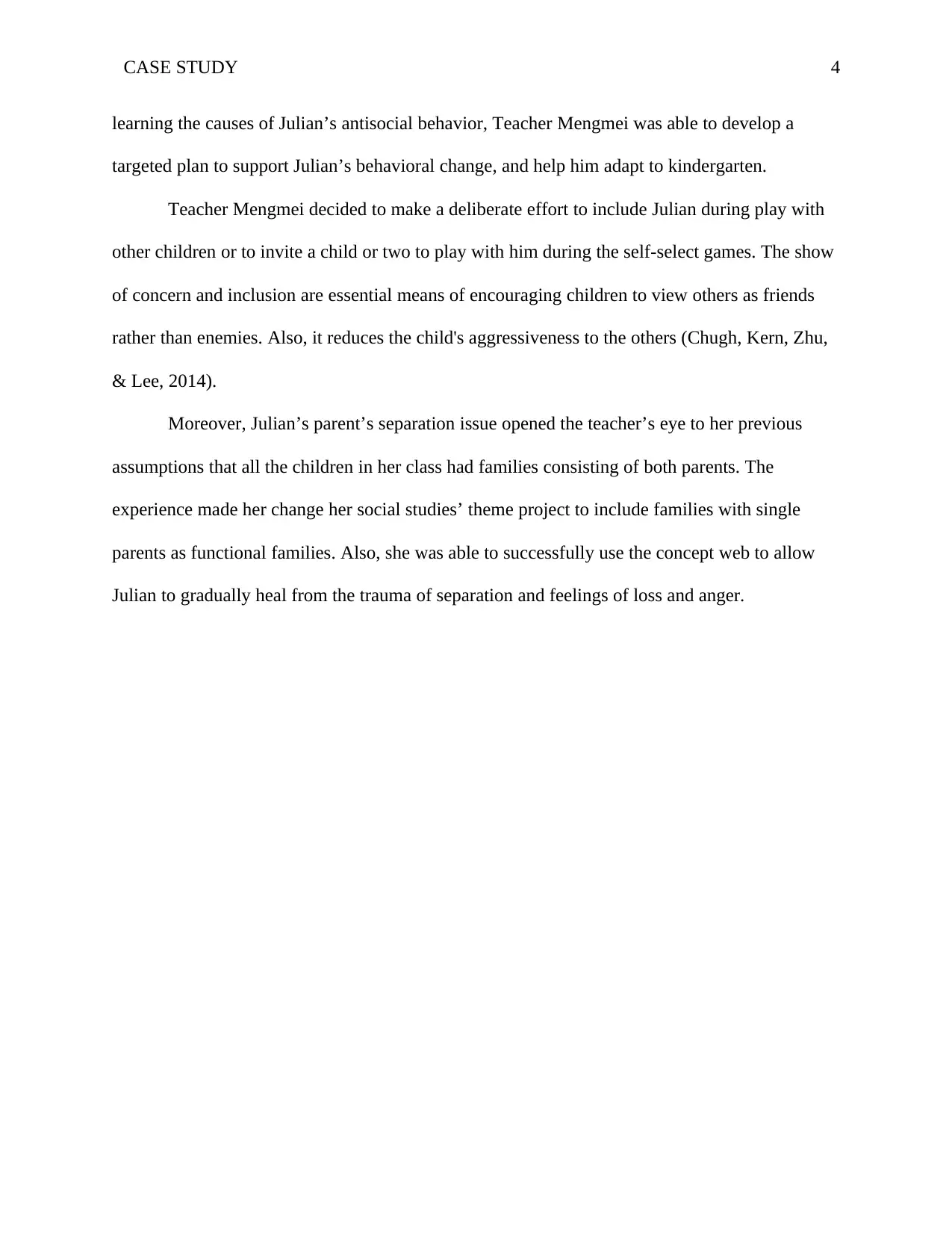
CASE STUDY 4
learning the causes of Julian’s antisocial behavior, Teacher Mengmei was able to develop a
targeted plan to support Julian’s behavioral change, and help him adapt to kindergarten.
Teacher Mengmei decided to make a deliberate effort to include Julian during play with
other children or to invite a child or two to play with him during the self-select games. The show
of concern and inclusion are essential means of encouraging children to view others as friends
rather than enemies. Also, it reduces the child's aggressiveness to the others (Chugh, Kern, Zhu,
& Lee, 2014).
Moreover, Julian’s parent’s separation issue opened the teacher’s eye to her previous
assumptions that all the children in her class had families consisting of both parents. The
experience made her change her social studies’ theme project to include families with single
parents as functional families. Also, she was able to successfully use the concept web to allow
Julian to gradually heal from the trauma of separation and feelings of loss and anger.
learning the causes of Julian’s antisocial behavior, Teacher Mengmei was able to develop a
targeted plan to support Julian’s behavioral change, and help him adapt to kindergarten.
Teacher Mengmei decided to make a deliberate effort to include Julian during play with
other children or to invite a child or two to play with him during the self-select games. The show
of concern and inclusion are essential means of encouraging children to view others as friends
rather than enemies. Also, it reduces the child's aggressiveness to the others (Chugh, Kern, Zhu,
& Lee, 2014).
Moreover, Julian’s parent’s separation issue opened the teacher’s eye to her previous
assumptions that all the children in her class had families consisting of both parents. The
experience made her change her social studies’ theme project to include families with single
parents as functional families. Also, she was able to successfully use the concept web to allow
Julian to gradually heal from the trauma of separation and feelings of loss and anger.
Paraphrase This Document
Need a fresh take? Get an instant paraphrase of this document with our AI Paraphraser
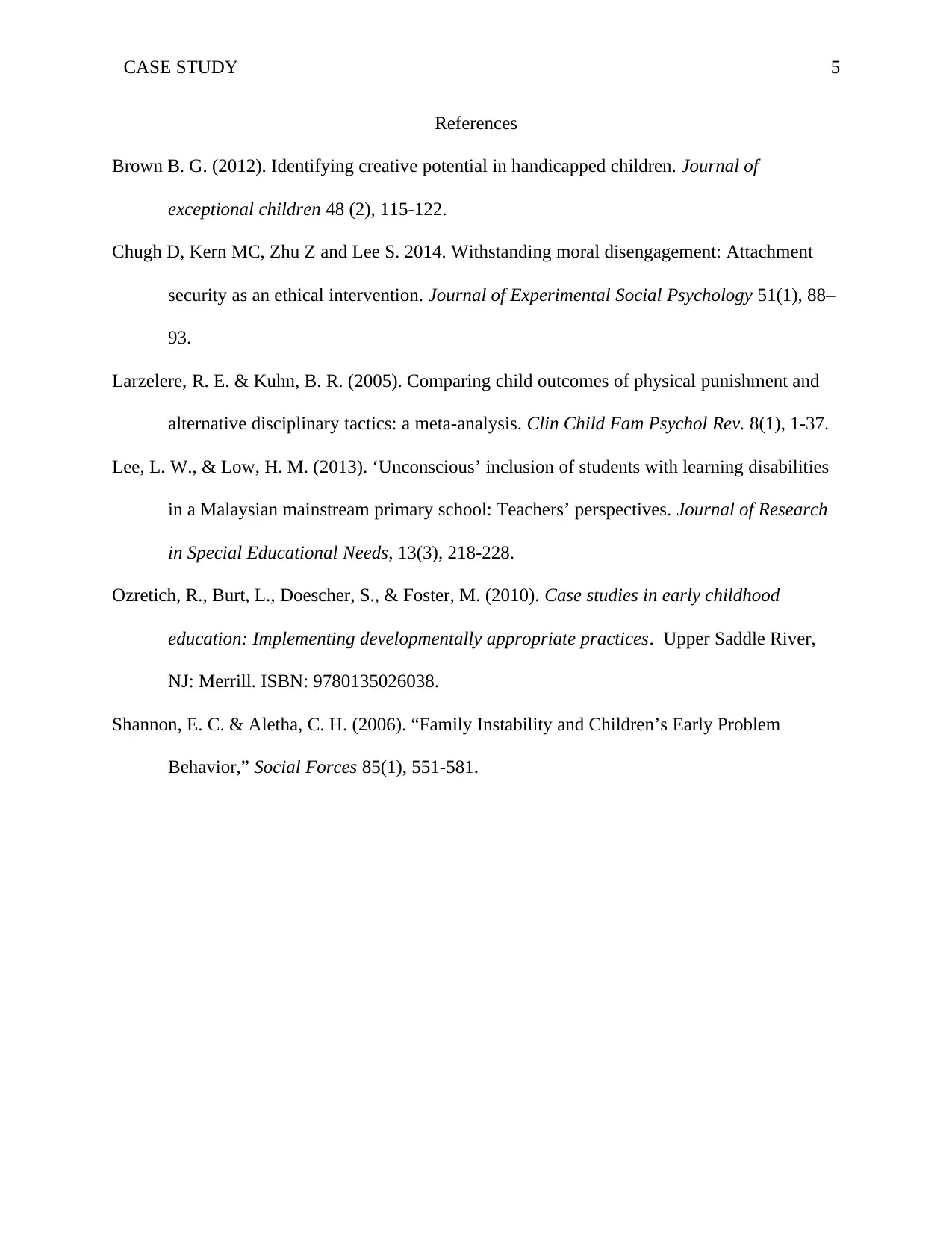
CASE STUDY 5
References
Brown B. G. (2012). Identifying creative potential in handicapped children. Journal of
exceptional children 48 (2), 115-122.
Chugh D, Kern MC, Zhu Z and Lee S. 2014. Withstanding moral disengagement: Attachment
security as an ethical intervention. Journal of Experimental Social Psychology 51(1), 88–
93.
Larzelere, R. E. & Kuhn, B. R. (2005). Comparing child outcomes of physical punishment and
alternative disciplinary tactics: a meta-analysis. Clin Child Fam Psychol Rev. 8(1), 1-37.
Lee, L. W., & Low, H. M. (2013). ‘Unconscious’ inclusion of students with learning disabilities
in a Malaysian mainstream primary school: Teachers’ perspectives. Journal of Research
in Special Educational Needs, 13(3), 218-228.
Ozretich, R., Burt, L., Doescher, S., & Foster, M. (2010). Case studies in early childhood
education: Implementing developmentally appropriate practices. Upper Saddle River,
NJ: Merrill. ISBN: 9780135026038.
Shannon, E. C. & Aletha, C. H. (2006). “Family Instability and Children’s Early Problem
Behavior,” Social Forces 85(1), 551-581.
References
Brown B. G. (2012). Identifying creative potential in handicapped children. Journal of
exceptional children 48 (2), 115-122.
Chugh D, Kern MC, Zhu Z and Lee S. 2014. Withstanding moral disengagement: Attachment
security as an ethical intervention. Journal of Experimental Social Psychology 51(1), 88–
93.
Larzelere, R. E. & Kuhn, B. R. (2005). Comparing child outcomes of physical punishment and
alternative disciplinary tactics: a meta-analysis. Clin Child Fam Psychol Rev. 8(1), 1-37.
Lee, L. W., & Low, H. M. (2013). ‘Unconscious’ inclusion of students with learning disabilities
in a Malaysian mainstream primary school: Teachers’ perspectives. Journal of Research
in Special Educational Needs, 13(3), 218-228.
Ozretich, R., Burt, L., Doescher, S., & Foster, M. (2010). Case studies in early childhood
education: Implementing developmentally appropriate practices. Upper Saddle River,
NJ: Merrill. ISBN: 9780135026038.
Shannon, E. C. & Aletha, C. H. (2006). “Family Instability and Children’s Early Problem
Behavior,” Social Forces 85(1), 551-581.
1 out of 5
Related Documents
Your All-in-One AI-Powered Toolkit for Academic Success.
+13062052269
info@desklib.com
Available 24*7 on WhatsApp / Email
![[object Object]](/_next/static/media/star-bottom.7253800d.svg)
Unlock your academic potential
Copyright © 2020–2025 A2Z Services. All Rights Reserved. Developed and managed by ZUCOL.





